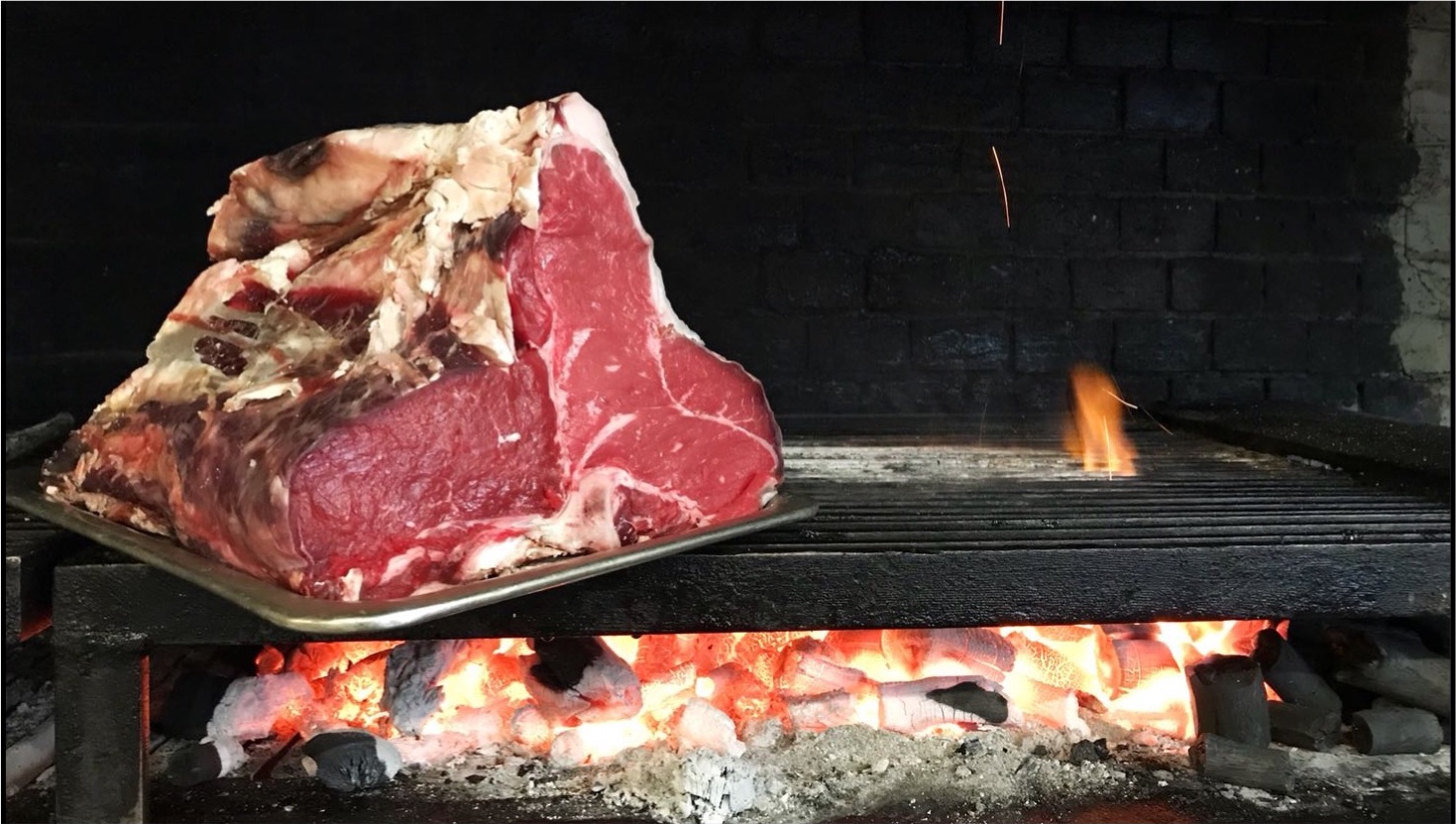The cooking of the Florentine steak.
The cooking of the Florentine steak is its essence. Cooking and eating a real Florentine steak is a sort of archaic ritual, but mind there is nothing simple in its preparation. All you need is: excellent loin meat, salt, pepper and embers. But there is a fifth ingredient, which is not to be found on the market stalls, due to time, passion and dedication; the fifth ingredient is experience. We always talk about time even when it comes to cooking. A Florentine rare steak is not a Florentine steak , and if it’s cold inside it’s not a “good” one. That’s why only the experienced eye of a passionate grill expert knows when it’s time to remove the precious meat from the fire. Only experience can tell us how long the meat has to rest on its T-bone so that the heat can reach the center of the steak without cooking it, only an “eye” accustomed to its colors and a “nose” to its perfumes knows how to dose the fire to make it crispy outside and warm but underdone inside, so as to savour this precious cut in all its splendid and succulent consistency. Surfing the net you can find many recipes about the Florentine steak that refer to an old popular saying: five have to be the centimeters of its thickness and five minutes of cooking for each side. A sort of 5×5, as if the steak was a picture frame produced in perfect thousends of copies, clones of each other by some multinational company. Actually every Florentine steak is fortunately unique in its kind as well as the animal from which it derives. Weight and thickness change, and the cooking minutes also change according to the intensity of the fire. In Florence there are many restaurants that offer Florentine steak, but for license reasons, they mostly use cost iron plates for cooking meat. In reality the real Florentine steak should be cooked on the grill, as we do at Braciere Malatesta. The fragrances given by wood are unique and irreplaceable. At Braciere Malatesta we use 60% precious woods from the Casentino forests and 40% Tuscan coal for our embers. From the wood to the fire it is the expert of the grill that has to dose it, to poke it, almost cuddling it and tame it, the flames carbonize the meat in its interior, on the other hand insufficient fire would only boile the steak. When the fire is at the right temperature, as it should always be, we can lay the Florentine steak. It’s a sacrilege to take it from the fridge and place it directly on the grill. It would be a violence for the “queen” of the meat. The Florentine steak must rest at room temperature for at least 4 hours before cooking. And now we turn it from one side to the other and The cooking of the Florentine steak.
The cooking of the Florentine steak is its essence. Cooking and eating a real Florentine steak is a sort of archaic ritual, but mind there is nothing simple in its preparation. All you need is: excellent loin meat, salt, pepper and embers. But there is a fifth ingredient, which is not to be found on the market stalls, due to time, passion and dedication; the fifth ingredient is experience. We always talk about time even when it comes to cooking. A Florentine rare steak is not a Florentine steak , and if it’s cold inside it’s not a “good” one. That’s why only the experienced eye of a passionate grill expert knows when it’s time to remove the precious meat from the fire. Only experience can tell us how long the meat has to rest on its T-bone so that the heat can reach the center of the steak without cooking it, only an “eye” accustomed to its colors and a “nose” to its perfumes knows how to dose the fire to make it crispy outside and warm but underdone inside, so as to savour this precious cut in all its splendid and succulent consistency. Surfing the net you can find many recipes about the Florentine steak that refer to an old popular saying: five have to be the centimeters of its thickness and five minutes of cooking for each side. A sort of 5×5, as if the steak was a picture frame produced in perfect thousends of copies, clones of each other by some multinational company. Actually every Florentine steak is fortunately unique in its kind as well as the animal from which it derives. Weight and thickness change, and the cooking minutes also change according to the intensity of the fire. In Florence there are many restaurants that offer Florentine steak, but for license reasons, they mostly use cost iron plates for cooking meat. In reality the real Florentine steak should be cooked on the grill, as we do at Braciere Malatesta. The fragrances given by wood are unique and irreplaceable. At Braciere Malatesta we use 60% precious woods from the Casentino forests and 40% Tuscan coal for our embers. From the wood to the fire it is the expert of the grill that has to dose it, to poke it, almost cuddling it and tame it, the flames carbonize the meat in its interior, on the other hand insufficient fire would only boile the steak. When the fire is at the right temperature, as it should always be, we can lay the Florentine steak. It’s a sacrilege to take it from the fridge and place it directly on the grill. It would be a violence for the “queen” of the meat. The Florentine steak must rest at room temperature for at least 4 hours before cooking. And now we turn it from one side to the other and everything smells good. In recent years the idea that adding salt during the cooking is a sacrilege and the final drop of olive oil is an abomination, nothing more wrong and alien to our origins, to our eyes, those of Braciere Malatesta, which they saw thousands and thousands of steak sizzling on the old grill for over 60 years and so they dissolved their doubts about each new theory by testing it personally. At Braciere Malatesta the results of their “experiments” are reminescent of past traditions. Salt and pepper halfway through cooking , according to tradition, at the end of cooking lean the loin on the bone to spread the heat to the heart of the meat. A final pinch of salt and a final drop of extra virgin olive oil from our Florentine hills and there you are, our steak is ready for the table to delight even the most demanding palates. And those who ask for a well done steak, they don’t deserve the pleasure that a Florentine steak can give. everything smells good. In recent years the idea that adding salt during the cooking is a sacrilege and the final drop of olive oil is an abomination, nothing more wrong and alien to our origins, to our eyes, those of Braciere Malatesta, which they saw thousands and thousands of steak sizzling on the old grill for over 60 years and so they dissolved their doubts about each new theory by testing it personally. At Braciere Malatesta the results of their “experiments” are reminescent of past traditions. Salt and pepper halfway through cooking , according to tradition, at the end of cooking lean the loin on the bone to spread the heat to the heart of the meat. A final pinch of salt and a final drop of extra virgin olive oil from our Florentine hills and there you are, our steak is ready for the table to delight even the most demanding palates. And those who ask for a well done steak, they don’t deserve the pleasure that a Florentine steak can give.

